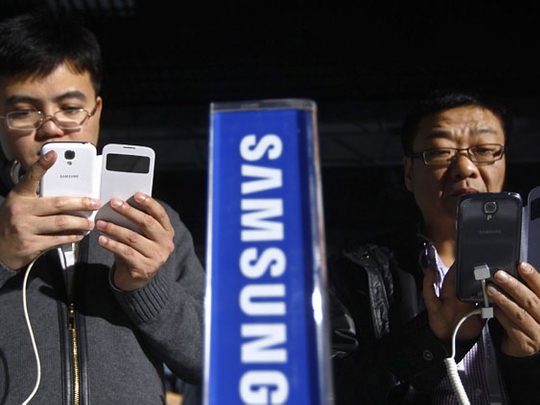
Seoul: Samsung Electronics, the world’s largest technology firm by revenue, on Friday posted another record quarterly net profit, but weakening earnings momentum has fuelled fears over flagging demand for high-end smartphones.
The South Korean giant said its April-June net profit surged 49.7 per cent year-on-year to 7.77 trillion won (Dh25.54 billion) thanks to robust shipments of its flagship Galaxy S smartphones and higher chip prices.
Second-quarter operating profit surged 47.5 per cent on-year to 9.53 trillion won in the same period as sales grew 20.7 per cent on-year to 57.46 trillion won.
The figures were in line with the firm’s forecast at the start of the month, although they were well short of expectations, which had been for an operating profit of 10 trillion won.
“Entering into a typically strong season for the IT industry, we expect earnings to continue to increase,” said Robert Yi, Senior Vice-President and Head of Investor Relations.
But he warned: “We cannot overlook delayed economic recovery in Europe and risks from increased competition for smartphone and other set products.”
However, Samsung’s share price has been falling — wiping about $30 billion off the firm’s value — since late April when the flagship Galaxy S4 hit stores, as sales have not been as high as hoped.
That is despite the company spending billions of dollars on a global marketing campaign, squeezing margins, after launching the latest gadget at a lavish New York event in late March.
Samsung fell 0.91 per cent to close Friday at 1,303,000 won.
“Expectations had been too high for high-end smartphone sales. Many investors now think the Galaxy S4 has not been selling so well,” Oh Young-Bo, of Hanmag Securities, told AFP.
He added that investors are growing concerned as Samsung relies heavily on sales of smartphones to drive growth.
With an expected drop-off in demand for high-end phones, brokerages began cutting their forecasts for earnings and sales in June.
Samsung did not reveal smartphone shipments but it is thought to have sold about 75 million in the past quarter, including around 20 million Galaxy S4s.
But while that helped Samsung maintain its status as the world’s largest handset maker, the figure is only slightly up from the estimated 70 million shifted in the previous three months, suggesting a slowdown in growth momentum.
That compares with Apple, which sold 31.2 million iPhones in April-June — a record for the quarter — compared with 37.4 million in the previous three months, according to research firm Strategy Analytics.
However, Apple’s fiscal third-quarter results on Tuesday showed net profit plunged 22 per cent year-on-year.
And while iPhone sales beat expectations, there are still fears for the high-end smartphone market as cheaper Android devices from China and emerging markets become more attractive options.
Samsung, Nokia Corp. and HTC Corp. are launching more affordable devices to diversify their product lineups, although analysts have warned that such a move could hit their profit margins in the longer term, analysts say.
Hanmag Securities’ Oh Young-Bo forecast Samsung’s operating profit would rise to 10.5 trillion won in the third quarter to the end of September, although he said this would mainly be thanks to sales of displays, semiconductors, and tablet computers.
For Samsung the IT and mobile sector contributed most of the second-quarter operating profit, producing 6.28 trillion won, up 52 per cent from a year earlier.
Semiconductors saw a 1.76 trillion won operating profit, up 71 per cent from a year earlier, while operating profit from displays surged 58 per cent year-on-year to 1.12 trillion won.











